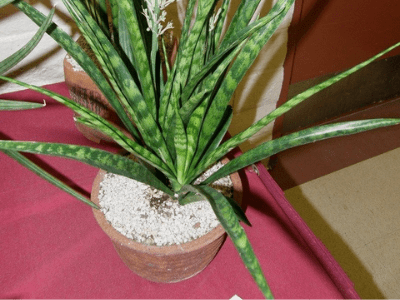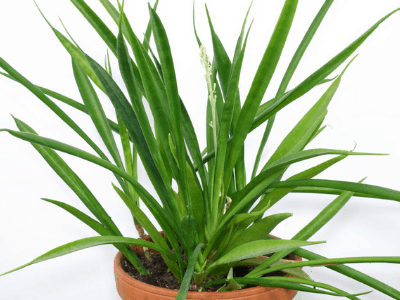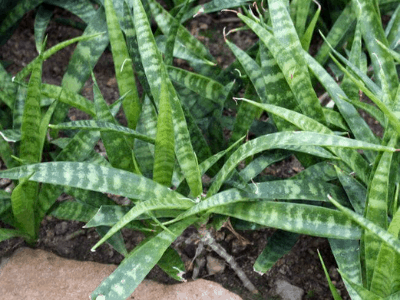Sansevieria Parva Care: Growing The Kenya Hyacinth
Sansevieria parva is a rare snake plant relative that you’ll want to add to your indoor houseplant collection…
….or outdoor garden if you like succulents. It will thrive in either situation, so hurry out to the nursery and get one…
…and let’s learn how to care for this beautiful succulent!
- Common Name: Kenya Hyacinth
- Scientific Name: Sansevieria parva
- Family: Asparagaceae
It’s also known as Kenya Hyacinth and is a popular container or outdoor landscaping plant.
However, this plant is frequently mistaken for Sansevieria dooneri. Even your neighborhood nursery…
….will be perplexed by the two! Sansevieria parva has thick, dark green banded leaves that grow out…
…of small heavy rosettes and are 8-16 inches long. It’s a great hanging basket houseplant because…
…it sends out long pendant runners called stolons that end in tiny plantlets.
At night, the small, pale pink to white flowers appear in spikes and have a fragrant hyacinth scent.
This flowering plant, which belongs to the Asparagaceae family, is native to Madagascar, Kenya, Burundi and South Asia.

Here’s the main thing
About Sansevieria Parva
Sansevieria parva ‘Gilt Edge’ is a slow-growing succulent with narrow, dark green leaves with yellow, light green…
….and golden banding. Sansevieria is a flowering plant genus with about 70 species native to Africa, Madagascar…
….and southern Asia. It is frequently classified as a member of the Dracaena genus. Both genera are classified…
…as Asparagaceae in the APG III classification system. Petagna named the genus Sanseverinia after his patron…
…Pietro Antonio Sanseverino, Count of Chiaromonte (1724-1771), but Thunberg changed the name…
…for unknown reasons, possibly influenced by the name Raimondo di Sangro (1710–1771), prince of San Severo in Italy.

Taxonomy Of Sansevieria Parva
Sansevieria is named after Raimondo di Sangro [1710–71], Prince of San Severo, an Italian scientist and inventor.
Vincenzo Petagna named the genus Sanseverinia after his patron Pietro Antonio Sanseverino…
….Count of Chiaromonte (1724–1771), who had seen the plant in his garden.
Sansevieria was a name used by Carl Peter Thunberg. Despite arguments that the author should be given as Petagna…
….it is unclear whether Thunberg’s name was intended to be new or was a typographical error…
…because Petagna’s name is a conserved name International Code of Nomenclature for algae, fungi, and plants.
The spellings “Sanseveria” and “Sanseviera” are also common, with the confusion stemming from the Italian place…
….name’s alternate spellings. Sansevieria was found to be nested within Dracaena, making the latter paraphyletic…
…unless Dracaena was expanded to include the species that were previously classified as Sansevieria.

Next up
Can A Sansevieria Parva Improve The Air Quality In Your Home?
Many plants are strategically placed throughout the house for decoration and to maintain feng shui.
Did you know, however, that some of these same plants have health benefits as well?
Continue reading to learn more about snake plants, their health benefits, and how to take care of one.
The snake plant, also known as mother-in-tongue, law’s is a hardy succulent that can grow from 6 inches…
…to several feet tall. Snake plants have a number of health benefits in addition to providing some ambiance.

Remove Toxic Pollutants
Snake plants are also known for their ability to remove harmful pollutants from the air. Snake plants can absorb…
…cancer-causing pollutants such as CO2, benzene, formaldehyde, xylene, and toluene, albeit in small amounts.
Snake plants can absorb and remove harmful toxins, making them an effective defense against allergies in the air.
Here we have story from Seth about his experience with his wife having Sansevieria Parva as their houseplant!

Go on…
Let us hear Seth’s story
I live in a small house, and my wife wanted to buy some Sansevieria Parva plants.
I didn’t want them around because they grow fast, take up space, and look ugly.
My wife then told me the reason why she got them was because they are good for purifying air inside the house.
She said that it could also create a calming environment with its nocturnal leaves.
Well, I had no counterargument so I just went out of the way to avoid her plants.
The thing is that when we have guests over our home can be cramped from time to time…
...so I let her plant stay on top of our dirty laundry bin which usually isn’t touched often anyways…
...since we always use the washing machine instead. Every time my wife always taking care of this plant…
…without any skipped day. After 1 month, I need to go to laundry bin and I see this plant growing…
...is beyond my expectation! It’s so healthy and big! Wow!
If you’re a succulent lover, Sansevieria parva is a rare snake plant relative that’s you’ll want to add to your indoor houseplant collection or outdoor garden. It will thrive in both situations, so run out to the nursery and pick one up and let’s learn how to care for this gorgeous succulent species!”
Kevin Espiritu, founder from epicgardening.com
Keep reading…
Sansevieria Parva Care
The parva in a ‘Lancet Variegated’ version. Sansevierias should be kept in filtered or moderately bright light.
A spot in front of a north-facing window or a bright, sunny window covered by a sheer curtain are both good choices.
The plant can survive in low light, but bright light brings out the colors in the leaves.
Intense light, on the other hand, may cause the edges of the leaves to yellow.
Light & Temperature
They can survive in a wide range of lighting conditions, but prefer moderately bright, indirect light.
If you’re growing plants indoors, a north-facing window or a bright sunny window with a sheer curtain is ideal.
They can grow in the shade, but bright light helps bring out the colors in the leaves, so keep them out…
…of the shade as much as possible. If the light is too strong, the leaves will become weak and elongated…
…and the edges will turn yellow. They thrive in temperatures ranging from 70 to 90 °F (21 to 32 °C).
Temperatures below 50 °F (10 °C) will cause the plants to suffer and die back.
Water & Humidity
In general, Sansevierias don’t require a lot of water. Frequent watering will cause root rot and eventually kill the plants.
They also grow best in moderate to low humidity conditions.
Water when the soil is fully dry. Let it drain through drainage holes, and discard the excess in the saucer.
During winter, decrease your watering.
Soil
Sansevieria parva requires a well-drained succulent mix with a pH of about 5-7.5 that is slightly acidic to neutral.
Allow the soil to dry completely before watering, and then water deeply until the drainage hole is filled.
Allow the pot to drain completely before discarding any remaining water in the saucer. Never let the soil become wet…
…and never submerge the pot in water. During the winter, water sparingly.
Sansevieria, like most succulent plants that store water in their leaves, rots quickly in wet soil.
It’s not over yet, keep reading!
Fertilizer
It doesn’t require much fertilizer, like most snake plants. The leaves will die if they are over-fertilized.
During the summer, when the plant begins to flower, you can feed it with a succulent fertilizer once every three weeks.
As directed on the container, dilute the fertilizer to half strength.
Repotting
Your pot may become top heavy due to the tall foliage. Repotting a snake plant is similar, with the exception…
…that you should use a wide but shallow pot. To keep it from becoming too rootbound, repot it every 2-3 years.
Propagation
Snake plant propagation can be accomplished in a number of ways. Sansevieria parva leaf cuttings will root quickly…
…if given good soil, warmth, and bright, filtered light. When propagating, it’s also important to water…
…and fertilize lightly. Between individual waterings, make sure the soil is completely dry.
You can transplant the young plants to a larger pot once they have established a strong root system.
Pruning
Mostly for aesthetic reasons.
To make the plant bushier and more appealing..
..you can prune any dead leaves or overgrown stems.
Growing Problems
To avoid cold damage, store at temperatures above 50 degrees Fahrenheit. It’s also important that the water…
….used to irrigate the plants isn’t too cold. Leaves that have been exposed to the cold develop whitish…
…water-soaked spots and eventually fall off.
Last but not least..
Pests
Vine weevils, grubs, mealy bugs..
..and spider mites are the most common pests that attack Sansevieria parva….
…but you can control them with good pest management techniques.
Sum Up
See having Snake plant is good choice for you to have!
It’s cool, its famous, it’s easy to have and care!
What else do you need?
In this pandemic time like this, is a good choice for you to have an new activity…
…and having snake plant is a good choice for you to have!
Conclusion
Last thing for sure. This plant need to be care carefully, remember plant need the “love” too.
Alright that’s all for today! Do you have any questions about all of this?
Or do you want to add some method to take care Sansevieria parva so it can grow big and healthy?
Let me know your recommendation from the comment below!
Check out more posts on our website like this one here!
I hope you can now take care your snake plant carefully and grow it big!
Thanks for reading this article! Bye!

